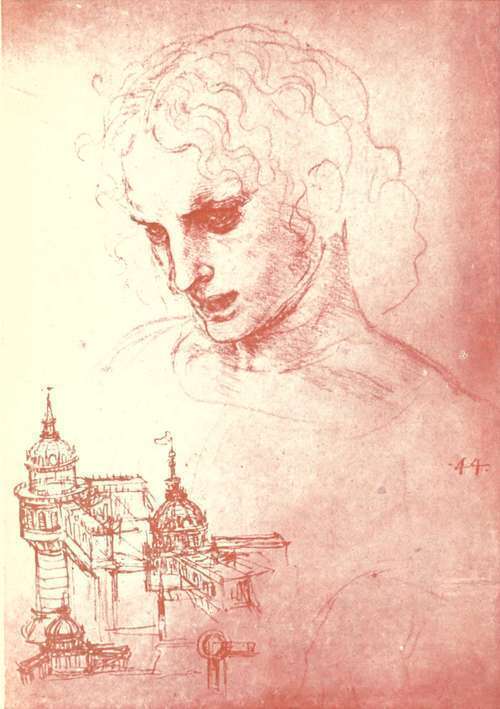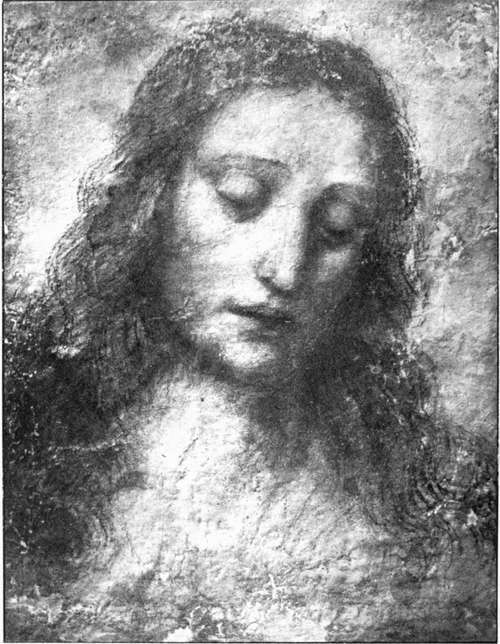The Pictures. Part 3
Description
This section is from the book "Leonardo Da Vinci", by Edward McCurdy. Also available from Amazon: Leonardo Da Vinci.
The Pictures. Part 3
In only one detail has he given free rein to the luxuriance of creative fancy. The wings of the angel are painted with a very perceptible delight and with care of the minutest. Row on row of feather and tufted plumage, the down quivering as it takes the light; long streaming feathers ending the wings; lesser feathers above them, and tufts of tiny feather and down nestling softly beneath the wing ! Why this minuteness, while the walls of the garden, and the walls and benches of the house are simple and bare?
Leonardo was more interested in wings. At Milan, and at a later period in Florence, he was engaged upon the invention of devices for flying. In connection with this project he studied the laws governing the flight of birds; and the treatise " Sul volo degli uccelli," written in Florence in the spring of 1505, records the result of his observations.
It was by reproducing the structure of the bird's wing in some mechanism capable of being attached to and worked by man that he looked to find solution of the problem.

Plate 26. Study For The Head Of S. James And Architectural Drawing
Mew Gallery Portfolio - Royal Library, Windsor
The Annunciation, painted when still a pupil of Verrocchio's, perhaps as early as 1470, contains the foreshadowing of things to come. The wings of the angel would support the weight of the body. Of how many other pictures of the Annunciation can as much be said?
Leonardo had at least reached his thirtieth year before he left Florence for Milan. He had then already been enrolled for ten years as a member of the Guild of Painters. The only other paintings still in existence which can be assigned to this first Florentine period are the S.Jerome in the Desert and the Adoration of the Magi, cartoons executed in ground colouring only. The fact leaves an irreparable blank in the history of his genesis as a colourist. The earliest to be executed was the S. Jerome. The history of the picture is adventurous enough. Cardinal Fesch found the major portion of it used as the lid of a box in a shop in Rome in the early part of last century. A panel containing the head had been cut out, and this he afterwards discovered hanging up in a shoemaker's shop. The reunited picture was acquired by Pius IX. and placed in the Vatican Gallery.
There is no documentary evidence relating to the picture or connecting the subject with any commission of Leonardo. It is assigned to him purely on internal grounds. The attitude of the saint kneeling on the left knee with right arm stretched out and with clenched hand holding a stone with which he beats his breast is exactly reproduced in a drawing at Windsor,1 which however is from a totally different point of view, the figure of the saint being seen in left profile, the body turning away from the observer and the left hand holding a crucifix.
1 Braun, 202.
Judging from the direction of the shading the drawing was made with the right hand; but the vigour of the modelling of the body would go far to establish its authorship even were it not plainly a variant of the same composition. The greater dramatic possibilities in the position finally adopted are evident in the cartoon.
The effect of intensity of suffering is realized to the full, yet without exaggeration, by the emaciated head and shrunken shoulders of the saint. The gaunt, protruding tendons of the neck are perhaps the more startlingly apparent in the grays and browns of the cartoon undraped in final colour.
Here, as in the modelling of the skull, the hand at work is that of the scientist; he must have already begun the systematic study of anatomy. The result is a triumph of realism of which the only contemporary parallels occur in Leonardo's other works.
The head seems later than the pen-drawing in the Uffizi (No. 446), dated 1478, of the deeply furrowed head of an old man. It is similar in result of method to the head of an old man with deeply sunken cheeks in the right of the Adoration, which it probably preceded in date of composition by a very short time.
On part of the background, which is uncovered by ground colouring, there is a rough sketch of the facade of a church, which bears a considerable resemblance to the new facade of Santa Maria Novella, constructed by Leo Battista Alberti in 1477. By the side of this on the extreme right is part of a nude figure seen in profile which may possibly be connected with his studies for the composition of a Sebastian.

Plate 27. The Head Of Christ
Hanfstangl photo - Brera Gallery, Milan
A comparison of the sketch with the drawings by Leonardo for this subject in the Bonnat Collection and at Hamburg1 suggests an identity of motive; but the sketch on the Vatican panel is so slight that it does no more than make possible the conjecture.
His drawings reveal how continually his mind was occupied in considering how to represent the subjects most generally treated of in Italian art. He almost drew as he thought. The pen's fleeting impress would seem at times simply intended to perpetuate the thought itself, limpid and elemental in first conception, volatile in the sway of possibilities as the conception grew in harmony of ordered purpose. Despite the insistence of its utterance the thought apparently often remained to the last in the stage of things tentative. So the drawings are projects-ships of dream set sailing, of which only a few ever came to port.
No one of the brief list of Leonardo's sacred figure compositions seems to have been associated in inception with the giving of any particular commission. The motive has slowly ripened in the mind of the artist. Sketch after sketch attests its growth long before the commission afforded the opportunity of executing it. The Last Supper was begun in Florence. The figure of Christ is twice sketched on a sheet of studies for the Adoration.
Continue to:
Tags
leonardo da vinci, pictures, drawings, galleries, statues, da vinci
